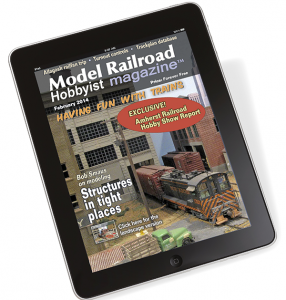With winter fast approaching and all of the upper deck sub-roadbed complete it will very soon be time to begin laying track. With that in mind I turned my attention back to the Tortoise switch machine control. Recall, many posts ago I was attempting to devise a means of controlling my switch machines with a momentary push button switch instead of the traditional bat handle toggle switch that is commonly used. I like the tactile feel of a soft touch momentary switch over the clack of a toggle. Additionally, push buttons don’t extend as far out from the fascia so there should be much less snagging of clothing and other similar accidents. The other factor at play is I want all of the controls on the railroad to match. Trivial detail I know, but it is what I want and rule #1 states “It’s my railroad and I’ll do what I want!”
Refer to this post for detail regarding the Tortoise control. There is a follow-up post with further refinements here.
I managed to get a reproducible production model assembled and working well. Feeling a bit creative today, I made a little flick to demonstrate how it works. Enjoy!
If you are a fan of full browser window HD playback then click here.
As seen in Model Railroad Hobbyist magazine.


Really nice video Allan. Interesting concept and excellent execution.
My plans will be to use manual throws as much as possible for all switches that are likely to be local control, and a few electric motors for switches under remote control by the tower operator(s). The idea is to keep it electrically simple. Fewer circuits are fewer to purchase and maintain.
You have an excellent layout concept and an even better execution. On a similar note the snagging issue with exposed switches is a real issue, and a few years ago I read about a rather clever solution a fellow modeler came up with.
He used empty 35 millimeter film canisters to allow him to mount sub miniature switches into holes drilled in the bottom of the canister. he then mounted the canister with out a lid to a hole drilled in his fascia and was able to pull the entire unit out for maintenance and when installed nothing projected into the isle of his railroad.
I am now thinking that a type of rotary switch is in my future so as to represent a dispatchers panel and then keep the same set up on remote sections of the layout.
Again really nice video and the execution of the concept should take a line from the Guinness Commercials, “Just Brilliant”.
I sure hope you have lots of back ups of this material as it would make an excellent “book” either or both print or electronic. Your concept and execution of building a model railroad is great and would be a huge benefit to the hobby if this became widely available.
Rob,
The eventual plan for fascia controls is the push button switches will mount in a Lexan fascia panel with the usual track schematic on it. Nothing new or revolutionary there, eh? Panels will be located at strategic points around the railroad. My twist on the matter is to mount the switch at the points illustration and then have the selected route illuminate in green for the length of the route. The deselected route would light in yellow. Haven’t worked out the details yet but am thinking bi-color SMD LEDs behind frosted Lexan. I like this approach because it could easily be constructed on a PC board. That part of the build is down the road a ways so who knows how it will actually come to pass.
I like the idea! I had a similar circuit using a toggle switch (not back to back DPDT switches) that I could use from multiple locations. I like to concept of one push button switch because that would match the rest of my panels.
I did my panels in powerpoint and they are similar to what you describe. I used a paper diagram sandwiched between two pieces of Lexan. My Description of it can be found here https://sites.google.com/site/coloradofrontrangerailroad/construction/block-detection-and-signaling/control-panels
Let know what you think and I can send you my powerpoint file.
Chuck,
Very classy looking panels you have there. You and I are on the same page panel-wise. Your idea of sandwiched paper might just be the light diffusion treatment I need for the LEDs on the backside. Would be easier than the stencil/mediablast process I was envisioning. Thanks for posting.
Very cleaver and simple! I understand the circuit diagram but the wiring leaves me confused.
White wire with green band is connected to???
Green wire I assume is -ve volts.
White wire with red band to one pole of switch the other switch pole goes to where ??
Sorry but confused the Tortoise swopping contacts is what I think is confusing me.
Thanks Doc Colin
Doc,
Check out this post for the answers you seek: https://lkorailroad.com/tortoise-control/
Allan,
The SCMRR club has started to place these switch controls at various points around our layout, to replace old switches on a remote board. Converting to DCC means engineers now follow their trains and can throw their own turnouts as needed.
Thanks for the great work you’ve done.
Ray Asst. Super SCMRR (CT)